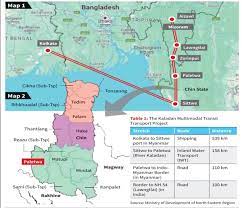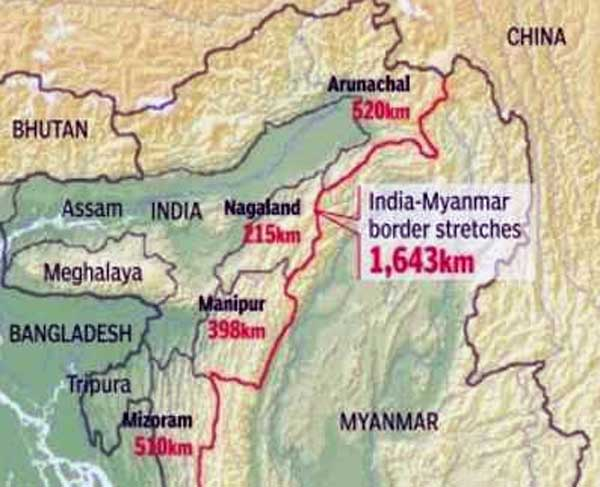
Impact of Myanmar Civil War on India's Strategic Interests
Impact of Myanmar Civil War on India's Strategic Interests
GS-II, III: International Relations, Internal Security
(UPSC/ State PSCs)
Important for Prelims
Myanmar Civil War, Kaladan Multimodal Transit Transport Project (KMTTP), Paletwa city, Aung San Suu Ky, Arakan Army, Ethnic Armed Organizations (EAOs).
Important for Mains
Myanmar Civil War, Cause, Impact of Myanmar civil war on India, Way Forward, Conclusion.
Feb. 07, 2024
Why in news:
Recently, the Arakan Army captured Paletwa in the Chin State, which lies on Myanmar’s western borders with Bangladesh and India.
Background of the war:
- In 2021, Myanmar's military leaders ousted the elected government of 'Aung San Suu Kyi'. Now, three years later, there is strong opposition to military rule. Ethnic Armed Organizations (EAOs) and the People's Defense Forces control several cities in different parts of the country. The Chin armed group and the Arakan Army are fighting Myanmar's military.
Cause of Myanmar Civil War:
- The city of Paletwa has sparked conflict between the Chin and Arakan ethnic groups.
- Paletwa is a commercial city on the Kaladan River, and therefore, any armed group with a significant presence in the city would benefit from economic activity in the area.
- Paletwa's strategic location on the western border makes it a good launchpad for Arakan Army operations.
- The majority of Paletwa's residents are Chin, who view the town as part of their homeland. However, some people in Rakhine State, formerly known as Arakan, argue that the city was historically part of the Arakan Highlands during colonial rule and should have been part of their province.
Arakan Army:
- The Arakan Army, along with the Myanmar National Democratic Alliance Army and the Tang National Liberation Army, is part of the Three Brotherhood alliance, which some claim is backed by China.
Impact of Myanmar civil war on India:
- India’s Northeastern border with Myanmar remains on top of the bilateral agenda.
- It has hampered the India initiatives in terms of land outreach towards the vibrant economies of South East Asia and has retarded development in the Northeast.
- It has forced thousands to flee into India.
- It has led to a series of unfortunate incidents that indicate a resurgence in anti-India posturing in the North Eastern region.
- This is creating impediments to the Centre’s overtures for future peace initiatives.
- It is seen as an adverse impact on its Act East policy.
- The ongoing civil war in Paletwa city will impact the Indian government's Kaladan Multimodal Transit Transport Project (KMTTP), which is already facing significant delays.
India’s Stand
- India had shown commitment to build a robust relationship with Myanmar over the past two decades which intensified after the democratic process began in 2011.
- India has taken an arguably balanced diplomatic approach on Myanmar, calling for restraint, restoration of democracy and release of political prisoners, but also maintaining its lines of communication with the military.
About Kaladan Multimodal Transit Transport Project (KMTTP):
- India and Myanmar signed the KMTTP in 2008 to address the geo-economic and geopolitical challenges of Northeast India.
- The objective of the Kaladan Project was to provide an alternative route to the sea for North-East India.
- Kolkata to Sittwe Port (Myanmar) - Shipping - 539 km
- Sittwe to Paletwa (Kaladan River) – Inland Water Transport (IWT) – 158 km
- Paletwa to India-Myanmar border (in Myanmar) - Road - 110 km
- NH-54 (Longtlai) Range (in India) - Road - 100 km.
- However, operations in Myanmar were delayed due to rugged terrain, inadequate inter-departmental coordination, political instability and security challenges.
- Although the Sittwe Port and inland water terminal in Paletwa have been completed, road construction faces challenges due to the current security situation in Myanmar.
Significance of this project for India:
- Transporting goods from Northeast India through the narrow Siliguri corridor is a costly affair, and in a worst-case scenario with China, movement along the corridor is likely to be adversely affected. Therefore, the Kaladan Project was envisioned as an alternative route providing sea access to Northeast India.

China's Investment in Myanmar:
- Currently, Chinese economic presence has increased substantially on the Bay of Bengal coast of Myanmar.
- China operates oil and natural gas pipelines from Shwe gas fields near Kyaukpyu in Rakhine State to China's Yunnan province.
- Two months ago, China had signed supplementary agreements with the Myanmar military to operationalize a deep sea port and a special economic zone near Kyaukpyu.
- Reportedly, there were renewed efforts to build a railway line from China's Yunnan to Kyaukpyu via Mandalay as part of the China-Myanmar Economic Corridor (CMEC).
- Unlike India, China is a permanent member of the UN Security Council, which leads many state and non-state actors in need of international support to be relatively more accommodating to China's concerns. As a result, China is in a position to provide political and military support to various ethnic armed groups as well as the Myanmar military to protect its economic interests.
Way Forward:
- India should implement an unbiased and proactive “Neighbourhood First” strategy that facilitates the Act East policy crucial for India’s long-term security and economic interests
- There is a need to ensure the continued economic development of Northeastern states.
- Positive overtures by the Government of India will not only improve the security situation but reassure the locals that the region’s interest is paramount.
- For speedy implementation, the attitude of local ethnic organizations towards the Kaladan project should be taken into account. The people of Mizoram and their co-ethnics across the border in Chin State are interested in the early completion of the Kaladan project, as it will spur economic activity in the region.
- The successful completion of Kaladan requires not only competent technical personnel, but also experts who can understand the dynamics of Chin-Arakan ethnic relations, the changing nature of military-EAO competition, especially communal violence in Rakhine State, and the growing Chinese presence in Myanmar.
Conclusion:
- In recent times, the Chin Armed Group and the Arakan Army have launched a Myanmar military civil war to establish their regional dominance, which indirectly involves China's involvement, which is likely to affect India's economic and strategic interests. Therefore, to maintain peace and order, it is imperative that the Chin and Arakan groups agree on an inclusive framework for the governance of Paletwa and surrounding areas. To effectively fight against the military, the EAO needs to improve inter-ethnic solidarity by constructively adjusting each other's viewpoints across ethnic boundaries.
Source: The Hindu
----------------------------------------------
Mains Question:
How does Myanmar's civil war contribute to the internal security challenge of ethnic violence in the northeastern states? Explain.
Discuss the way forward for the negative impacts of Myanmar's civil war on India's strategic interests.